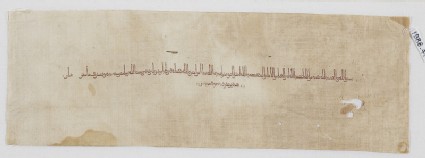Browse: 2422 objects
- Reference URL
Actions
Textile fragment with tiraz band in Kufic script
-
Description
This fragment is one of the earliest dated Islamic textiles in the Ashmolean collection. Embroidered in red silk, the inscription contains the names of the Abbasid caliph al-Mu’tadid bi’llah (ruled AD 892-901) and the Tulunid ruler of Egypt Harun ibn Khumarawayh (ruled AD 896-904), in addition to specifying where the textile was produced, Tinnis, and the year in which it was made, AH 288 (AD 900-901). In the Islamic tradition, the word tiraz is used to indicate both the fabrics embroidered with the name and titles of a caliph, and the factories where these fabrics were manufactured. Such textiles were generally used to make robes that were either worn by the ruler or given as gifts to members of the family, courtiers, and foreign officials.
-
Details
- Associated place
- Date
-
AD 900 - 901 (AH 288)
Tulunid Period (AD 868 - 905)
- Associated people
-
al-Mu'tadid bi’llah (AD 860 - 902) (subject)Harun ibn Khumarawayh (ruled AD 896 - 904) (subject)
- Material and technique
- linen, glazed, and embroidered with silk
- Dimensions
-
31.5 x 11 cm (length x width)
along length/width 32 / 32 threads/cm (thread count)
ground fabric 0.05 cm (thread diameter)
additional fibre, embroidery 0.04 cm (thread diameter)
- Material index
-
organic › animal › animal product › silk
- Technique index
-
assembled › woven › plain woven,woven › plain woven,
- Object type index
-
textile › cloth › burial-cloth
- No. of items
- 1
- Credit line
- Presented by Professor Percy Newberry, 1941.
- Accession no.
- EA1988.47
-
Further reading
Ellis, Marianne, Embroideries and Samplers from Islamic Egypt (Oxford: Ashmolean Museum, in association with Greenville: Curious Works Press, 2001), no. 1 on p. 12, p. 7, illus. p. 12
Britton, Nancy Pence, ‘Pre-Mameluke Tiraz in the Newberry Collection’, Ars Islamica, 9, (1942), cat. 159, fig.13
Barnes, Ruth and Marianne Ellis, ‘The Newberry Collection of Islamic Embroideries’, 4 vols, 2001, Oxford, Ashmolean Museum, cat. vol. iii, vol. i p. 17, illus. vol. i
Glossary
kufic
-
kufic
A term denoting various styles of angular Arabic script. Emerged in the early centuries of Islam, kufic soon became the preferred hand to copy holy texts.
Location
Objects are sometimes moved to a different location. Our object location data is usually updated on a monthly basis. Contact the Jameel Study Centre if you are planning to visit the museum to see a particular object on display, or would like to arrange an appointment to see an object in our reserve collections.
Publications online
-

Embroideries and Samplers from Islamic Egypt
This is a detail from one of the earliest embroideries in the collection, and one of the very few that can be securely dated. The inscription mentions both Harun, the Tulunid ruler of Egypt from 896-905, and the Abbasid caliph al-Mu'tadid bi'llah, (892-902). It reads “ln the name of God. Praise be to God. The favour of God to the servant of God. Abu'l-‘Abbas, the Imam, al-Mu'tadid bi'llah, Commander of the Faithful, may God strengthen him. This is what he ordered, may God glorify him, to be made in the workshop of Tinnis, at the hands of 'Ubaid Allah, son of Sulaiman, in the year 288 [A.D. 901]. Peace. l-larun, son of Khumarawaih, client of the Commander of the Faithful " (Britton 1942). Tinnis, on the north-eastern side of the Nile delta, was renowned for its linen industry. The word tiraz originated from a Persian term meaning “to embroider" but subsequently came to mean an honorific robe bearing woven or embroidered inscriptions. The writing may indicate the royal or state workshop where the cloth was manufactured and decorated. Such inscriptions continued in use throughout the 10th century. This fragment has come from a garment, perhaps a robe, turban cloth, shawl or sash that was finally used as a burial shroud although not made specifically for this purpose. According to Essie Newberry's account in the journal ‘Embroidery’ in 1940, it came from a cemetery near Atfeh, some sixty-five kilometres south of Cairo.
The letterforms are in angular kufic script and although the scale here is minute (a single upstroke is only 8mm high), the embroiderer has succeeded in conveying the elegant quality of the original calligraphy. The worker has transformed the letter forms into needlework using different stitches. He or she started by withdrawing a weft thread and replacing it by a double line of back stitches and then worked the upstrokes in counted slanted satin stitches and outlined them in tiny running stitches. Where the letters had curves, the embroiderer simply couched down a thread to the required shape. This is very different from the continuous chain stitch embroidery nearly always worked on embroidered tiraz bands from Iraq and Iran. The explanation for this probably lies in the fact that the Egyptian textile workers had been accustomed to adding decoration by tapestry-weaving. Embroidery was probably a new technique, whereas further East there was a tradition of chain stitch embroidery. -

The Newberry Collection of Islamic Embroideries
A complete tiraz inscription, very finely embroidered. It reads "Bismillah al-hamdu lillah ni'mat min allah li 'abdallah Abi'l-'Abbas al-imam al-Mu'tadid billah amir al-mu'minin ayyadahu allah mimma 'umira a'azzahu allah bi 'amlihi fi tiraz Tinnis 'ala yadai 'Ubaidallah ibn Sulayman sanat thamaniya wa thamanin wa mi'atain salam Harun ibn Khumarawaih mawla (amir) al-mu'minin" (In the name of God, praise be to God, the favour of God to the servant of God Abu'l-Abbas, the Imam, al-Mu'tadid billah, Commander of the Faithful, may God support him. Among the things ordered, may God glorify him, to be made in the tiraz at Tinnis at the hands of 'Ubaidallah son of Sulayman in the year 288. Peace. Harun son of Khumarawaih, client of the Commander of the Faithful).
The textile therefore was made in Tinnis, in Egypt, in the year 901 A.D. According to Newberry it was found at a cemetery near Atfal, 40 miles south of Cairo.
Galleries
© 2013 University of Oxford - Ashmolean Museum




